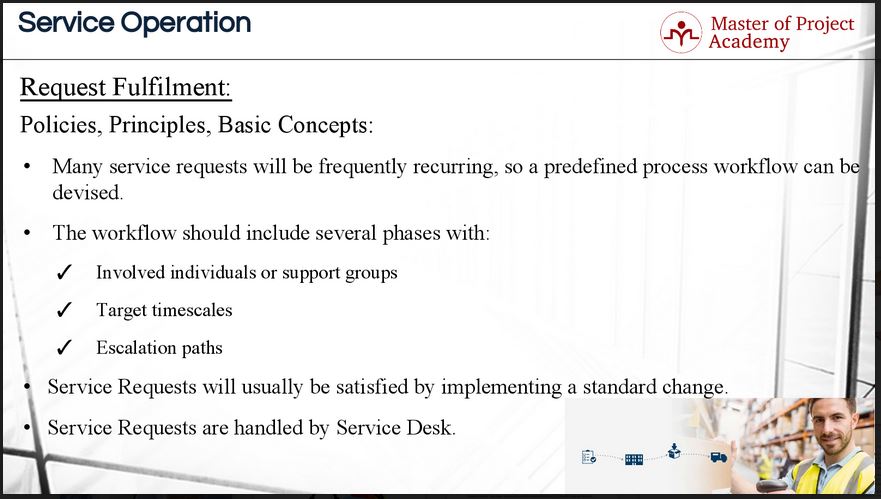The ITIL Service Operation stage of the ITIL lifecycle has several processes that help to achieve the primary objectives of this critical stage. Service Operation is the stage where customers can access services and therefore, customer satisfaction is vital. One of the processes in the Service Operation stage, as described in the ITIL course, is the Request Fulfillment Process. In this process, all requests submitted by users are handled according to certain pre-defined protocols that are designed for flawless feedback that will ensure customer satisfaction. If the request fulfillment process is followed properly according to ITIL Foundation Training guidelines, service requests will not result in a decrease in service quality and customer dissatisfaction which will ultimately lead to negative consequences for the business.
Request fulfillment process objectives
The primary goal of the request fulfillment process is the provision of a workflow for users to request and receive a standard service. Examples of standard services are: providing a new notebook to a new employee of a company, resetting the account of a user who blocked his password, or changing laptops of employees if they exceeded three years of operation. These are examples of standard service and managed by the request fulfillment process.
The existence of a predefined approval and authorization process for standard services is the objective of the request fulfillment process as well. For instance, to reset the password of a user, there can be some approval process, or to provide a new notebook to an employee, his manager’s approval might be needed. These kinds of approval and authorization processes are determined in the request fulfillment process.

Another objective of the request fulfillment process is the provision of information to users and customers about the availability of services and processes. Services are used by the end customers. If there will be any outage or service degradation in the usage of a service in an IT Service provider, users might be notified beforehand. For instance, there can be a system upgrade or maintenance. And until the upgrade or maintenance finishes, users might not be using some of the services correctly. These kinds of information must be provided to customers as an objective of the request fulfillment process.
Acquiring and delivering components of requested standard services, for example, licenses and software data carriers is another objective of request fulfillment process. We have given the provisioning of a new notebook to a new employee as a service request example. The laptop will require additional software and applications. For instance, the Microsoft Office package or there can be other company specific software applications as well. Providing these kinds of licenses are also an objective of request fulfillment process.
The last goal of the request fulfillment process is providing support with general information, explanations, and providing support in the case of complaints. For instance, the customer of a bank might not know how to transfer money to his friend’s account, or subscriber of a telecom operator might not know how to pay for its prepaid line. These kinds of services require certain steps to follow and standard services. And providing this general information and explanations are one of the objectives of the request fulfillment process.
The value of the request fulfillment process
The request fulfillment process may seem like a simple ITIL process, but it is immensely valuable to the organization. It is a useful process for the following reasons:
- It provides quick and efficient access to standard services which improves end-users productivity and the quality of business services
- Its predefined request fulfillment protocol reduces the bureaucracy involved in requesting and receiving access to new or existing services
- It reduces the costs of providing standard services
- It increases the level of control over requested services through a centralized fulfillment function
Basic concepts of the request fulfillment process
Many service requests in an IT Service Provider will be recurring so a predefined process workflow can be devised. We have given resetting the account of a user and providing a notebook for a new employee as the examples of service requests. These service requests have common steps so a workflow can be determined. For instance, resetting a user account of a user will require same steps to follow whenever a user locks his account, and these kinds of workflows should include several phases with:
- Involved individuals or support groups
- Target timescales
- Escalation paths

For instance, who should approve the new notebook provision for an employee? What is the target time to provision a new notebook when the user had problems with his existing notebook? These kinds of details must be clarified in the request fulfillment process workflows as we described in incident models.
Service requests will usually be satisfied by implementing a standard change. As described already, service requests have common and usual steps to follow and are handled by the service desk. Service desk monitors escalate, dispatches, and often fulfills the user request. If we consider the resetting of a user’s account, it will have similar steps for each locked user account. And after following the predefined steps, service desk personnel will guide the user to unlock his account without any further escalation within the IT Service Provider.
The request fulfillment process is a very useful process in the Service Operation stage of the ITIL service lifecycle. It helps to streamline the response to service requests. By providing standard working protocols as part of the request fulfillment process, the service desk will have no problem to address service requests in a timely and cost efficient manner. The request fulfillment process is a tool that leads to satisfied end-users and therefore adds value to the business.
Review by: Beverly Rice

